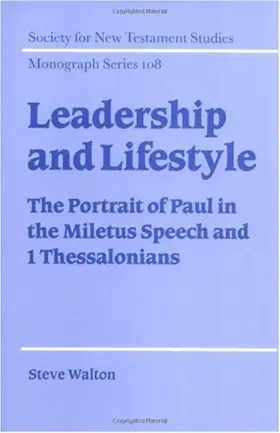

Leadership and Lifestyle: The Portrait of Paul in the Miletus Speech and 1 Thessalonians
in Society for New Testament Studies Monograph Series
Pages
272
Publisher
Cambridge University Press
Published
2000
ISBN-13
9780521780063
This book offers a clear, thoughtful portrait of early Christian understandings of leadership by studying Paul's speech at Miletus (Acts 20.18b-35). Dr. Walton compares the picture found there with Luke's presentation of Jesus' model of leadership and Paul's self-portrait in 1 Thessalonians. It will assist scholars in considering Luke's portrait of Paul in Acts by providing helpful criteria for identifying parallel ideas, as well as by showing that Luke and Paul are very close in their understanding of how Christian leaders are to lead.
Reviews
Society for New Testament Studies Monograph Series 108 New York: Cambridge University Press, 2000. Pp. xiv + 256, Cloth, $60.00, ISBN 0521780063. Kenneth A. Fox Wycliffe College This revised Sheffield dissertation contributes to the debate whether Luke’s portrait of Paul is compatible with Paul’s letters. After a “detailed study” (199), Walton concludes that “Luke’s Paul, when he speaks to Christians as a pastor, sounds like Paul writing as a pastor” (213). This does not mean that Luke had access to Paul’s letters but that “Luke knows Pauline tradition rather better than is sometimes suggested” (212). Whether that knowledge came from knowing Paul or from “independent Pauline tradition” is left open (212). Either way, Luke “seeks to pass on and commend Paul’s tradition, especially concerning Christian leadership” (212). Several considerations lead Walton to compare the Miletus speech with only one Pauline letter. His survey of scholarship (ch. 1) shows the pivotal place of the speech in the interlocking debates concerning Luke’s depiction of Paul and his knowledge of Paul’s letters. Further, while comparisons have been made between the speech and the Pauline corpus, “a systematic comparison of the speech with an individual letter has not previously been made” (140). Moreover, 1 Thessalonians is indisputably Pauline (140) and, like the Miletus speech, is “pastorally oriented” (141). After a review (ch. 2) of scholarly approaches to the structural parallels between Luke and Acts, Walton lays out and justifies his plan of action. Since knowing what is due to Lukan redaction will help determine how Lukan the Miletus speech is (46-47), the author begins by examining several speeches in Luke’s Gospel, namely, Luke 22:14-38; 12:1-53; and 21:5-31. This is carried out in chapter 4.
[Full Review]
